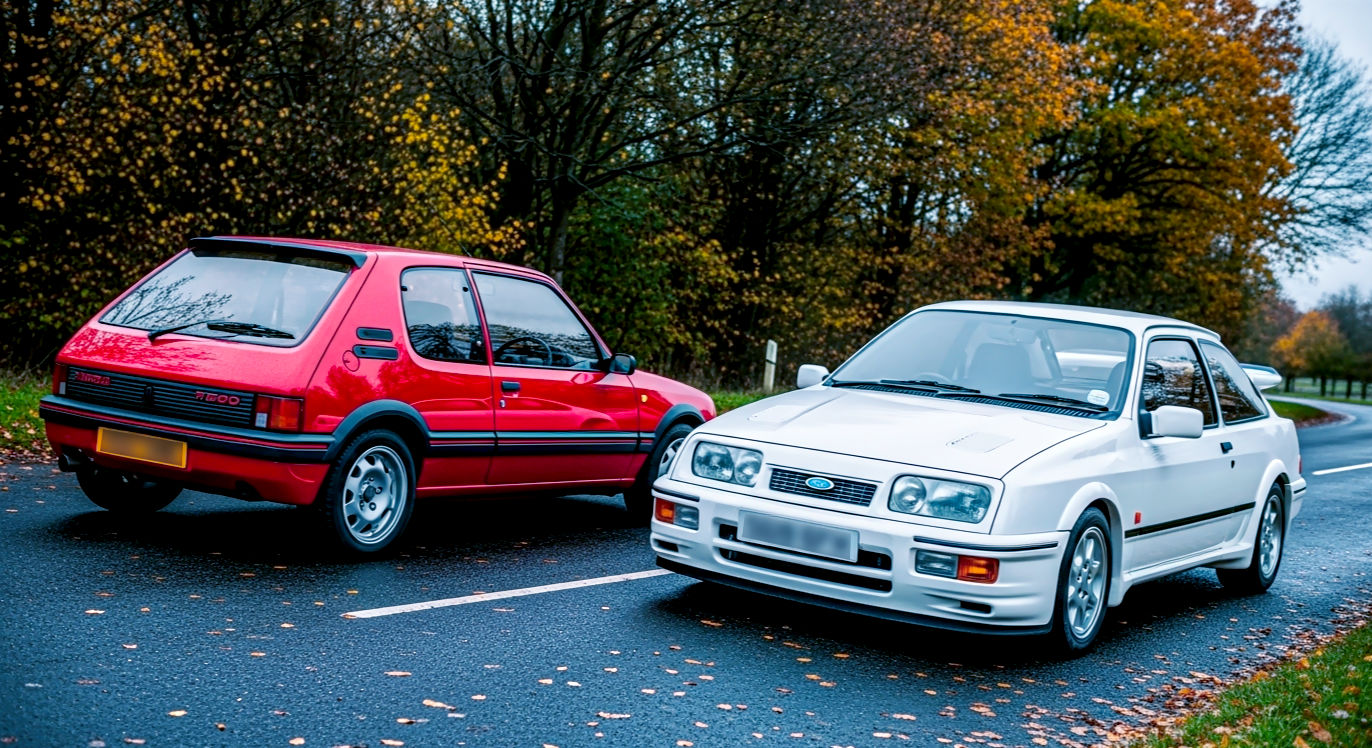From Hot Hatches to High-Flyers: The Definitive Guide to the 10 Best Cars of the 80s
A deep dive into the 10 most iconic cars of the 1980s. We explore the hot hatches, supercars, and yuppie saloons that left a lasting mark on British roads and culture.

This post may contain affiliate links. If you make a purchase through these links, we may earn a commission at no additional cost to you.
The 1980s. A decade of big hair, bold fashion, and even bolder cars. It was a time when shoulder pads were wide, mobile phones were the size of bricks, and your car said everything about who you were. For Britain, the 80s was a period of massive change, and the cars on our roads reflected that. We saw the birth of the hot hatch, the rise of yuppie power saloons, and the arrival of futuristic designs that looked like they’d driven straight off a sci-fi film set.
These weren’t just lumps of metal for getting from A to B. They were symbols of aspiration, freedom, and fun. They were the cars pinned on bedroom walls, the stars of TV shows like The Professionals and Only Fools and Horses, and the soundtrack to our lives was often the roar of a tuned-up engine or the tinny sound of a cassette player.
But which ones were the best? Which cars truly defined the decade and have earned their place as nostalgic classics? It’s a tough question, and one that’s guaranteed to start a debate down the pub. But after much thought, we’ve put together the definitive list. This isn’t just about speed or looks; it’s about impact, personality, and the indelible mark these machines left on British culture. So, buckle up and let’s take a trip back in time to rediscover the top 10 best cars of the 1980s.
What Made 80s Cars So Special?
Before we dive into the list, it’s worth remembering what made this era of motoring so unique. The 1970s had been a bit grim, with fuel crises and dreary, unreliable cars. The 80s felt like a breath of fresh air. Car makers started to get their mojo back, and technology that was once reserved for supercars began to trickle down to everyday motors.
Turbocharging became the buzzword of the decade. Sticking a turbo on an engine was like giving it a shot of adrenaline. It was a relatively cheap way to get a massive power boost, turning humble family hatchbacks into tyre-squealing pocket rockets. Suddenly, cars like the Renault 5 GT Turbo and Ford Escort RS Turbo were the kings of the traffic light Grand Prix.
Aerodynamics also became a big deal. Car designers swapped boxy shapes for sleek, wedge-like profiles that cut through the air more efficiently. This wasn’t just about looking cool; it helped make cars faster and more fuel-efficient. The Ford Sierra and Audi 100 were pioneers of this slippery new design language.
Inside, things were getting more futuristic too. Digital dashboards, with their glowing green numbers and blocky graphics, looked like something out of Knight Rider. You also got features like electric windows, central locking, and trip computers, which felt incredibly high-tech at the time.
Most importantly, 80s cars had character. They weren’t all designed by computers to be perfectly efficient and safe. They had quirks, flaws, and personalities. It’s this character that makes them so beloved today and why a whole generation of enthusiasts are now lovingly restoring them.
The Countdown: Our Top 10 Cars of the 1980s
Right, let’s get down to business. Here are our picks for the 10 cars that defined the decade.
10. Austin Metro (1980-1990)
Kicking off our list is a true British icon: the Austin Metro. Billed as “a British car to beat the world,” the Metro was the little car with a big job – to save the struggling British Leyland. And for a while, it did. It was an instant hit, loved for its cheeky looks, surprisingly roomy interior (thanks to its clever packaging), and nippy handling.
It was the car that millions of people learned to drive in. It was a common sight on every suburban street, often seen being polished on a Sunday morning. Princess Diana famously had a red one before she was married, which instantly made it one of the coolest cars a young person could own.
Of course, it wasn’t perfect. Rust was a persistent enemy, and the build quality could be a bit hit-and-miss. But the Metro had a charm that was impossible to resist. The sporty MG Metro and the bonkers, mid-engined 6R4 rally car (a true Group B monster) also gave the little supermini some serious street cred. It was a symbol of plucky British determination, and for that, it deserves its place on this list.
9. Renault 5 GT Turbo (1985-1991)
If the 80s was the decade of the hot hatch, the Renault 5 GT Turbo was its wild-child poster boy. While the Golf GTI was the sensible, grown-up choice, the Renault was its lairy, unpredictable cousin from across the Channel. It was small, incredibly light, and fitted with a turbocharger that had a personality all of its own.
Driving a GT Turbo was an event. You’d press the accelerator, and for a second, not much would happen. This was turbo lag. Then, as the turbo spooled up, all hell would break loose. The car would surge forward with a ferocity that was genuinely shocking, the steering wheel writhing in your hands. It was an intense, exhilarating, and slightly terrifying experience.
It wasn’t a car for the faint-hearted. The brakes weren’t brilliant, and the handling could be tricky if you didn’t know what you were doing. But get it right, and it was one of the most rewarding cars you could drive. Its boxy, flared wheel arches and iconic graphics screamed 80s performance. It was the definitive pocket rocket.
8. Ford Sierra RS Cosworth (1986-1987)
“Cossie.” Just the name is enough to give car fans of a certain age goosebumps. The Ford Sierra RS Cosworth was a monster created for one reason: to win touring car races. To do that, Ford had to build 5,000 of them for the road. The result was a legend.
At first glance, it looked like a souped-up family saloon, but the clues were there. The massive, almost cartoonish whale-tail rear wing was the biggest giveaway. It was there for a reason – to keep the car stable at its 150 mph top speed. Under the bonnet was a 2.0-litre turbocharged engine developed by engineering wizards Cosworth, pumping out a mighty 204 horsepower. In 1986, that was supercar territory.
The Sierra Cosworth became an instant icon. It was the blue-collar hero, the car that an ordinary person could aspire to own that could humble Porsches and Ferraris. Unfortunately, its performance and fame also made it a target for thieves, becoming one of the most stolen cars in the UK. But its reputation as the ultimate working-class supercar was cemented. It was raw, aggressive, and unapologetically brilliant.
7. BMW M3 (E30) (1986-1991)
While Ford was creating its touring car legend with the Sierra, BMW was doing the same with the 3 Series. The result was the E30 M3, a car now regarded as one of the greatest driving machines of all time.
Like the Cosworth, the M3 was built for racing. It shared its basic shape with the regular 3 Series, but almost every body panel was unique. The flared, boxy wheel arches, deeper front spoiler, and distinctive rear wing all screamed performance. It was powered by a high-revving, naturally-aspirated four-cylinder engine that loved to be thrashed.
What made the M3 so special was its incredible balance and feedback. It felt like an extension of the driver. The steering was telepathic, the chassis was sublime, and the engine sang a glorious mechanical tune. It wasn’t the fastest car in a straight line, but on a twisting B-road, very little could keep up with it.
It was also a symbol of 80s yuppie culture. It was the car driven by successful city traders, a status symbol that said you appreciated sophisticated German engineering over brutish horsepower. Today, it’s a blue-chip classic, with prices having gone through the roof, a testament to its legendary status.
6. Ferrari F40 (1987-1992)
No list of 80s cars would be complete without a true-blue supercar. And they don’t come more super than the Ferrari F40. Built to celebrate Ferrari’s 40th anniversary, it was the last car personally approved by the great Enzo Ferrari himself. It was a racing car for the road, pure and simple.
The F40 was raw and uncompromising. The body was made from lightweight materials like carbon fibre and Kevlar, and the interior was stripped bare. There were no carpets, no stereo, and you even had to pull on a cable to open the door. The windows were plastic sliders. Everything was focused on saving weight and maximising performance.
Behind the driver sat a twin-turbocharged V8 engine that produced a monstrous 478 horsepower. It was the first production car to officially break the 200 mph barrier. The performance was, and still is, breathtaking. The turbos delivered their power with a savage kick that required skill and bravery to tame.
The F40 was the ultimate poster car. Its aggressive, wing-clad shape was an icon of late-80s excess. It wasn’t just a car; it was an event, a statement, and arguably the last of the truly analogue supercars.
5. Lancia Delta Integrale (1987-1994)
The Lancia Delta Integrale is a god among rally fans. This boxy Italian hatchback dominated the World Rally Championship, winning six consecutive manufacturers’ titles between 1987 and 1992. The road-going versions were built to celebrate this success, and they were utterly brilliant.
What made the Integrale so special was its combination of a powerful turbocharged engine and a sophisticated four-wheel-drive system. This meant it could deploy its power with incredible effectiveness, no matter the weather or the road surface. On a wet, bumpy British B-road, an Integrale was practically unbeatable.
It had a purposeful, muscular stance, with blistered wheel arches struggling to contain its wide tyres. It wasn’t pretty in the classical sense, but it looked mean and ready for business. The driving experience was just as intense. It was incredibly fast, grippy, and involving.
Like many Italian cars of the era, it had its quirks and required dedicated maintenance. But for those who knew, the Delta Integrale was one of the most capable and exciting real-world performance cars ever made. A true rally legend for the road.
4. Ford Capri 2.8 Injection (1981-1986)
“The car you always promised yourself.” That was Ford’s advertising slogan for the Capri, and it was spot on. The Capri offered coupe styling and sporty performance for the price of a family saloon. It was the working man’s dream car.
By the 1980s, the Capri was an old design, but Ford gave it a new lease of life with the 2.8 Injection model. They ditched the old carburettor engine and replaced it with a fuel-injected 2.8-litre V6 from the Granada. It transformed the car, giving it 160 horsepower, a 130 mph top speed, and a wonderfully muscular engine note.
The Capri was famous for its long bonnet and tail-happy handling. It was a car that demanded to be driven with a bit of flair. It became a cultural icon in Britain, famously starring alongside Bodie and Doyle in the TV show The Professionals. It was a bit of a throwback, an old-school muscle car in a world of new-fangled hot hatches, but that was all part of its charm. It was affordable, fun, and looked fantastic.
3. Porsche 911 Carrera 3.2 (1984-1989)
The Porsche 911 is a timeless classic, but the Carrera 3.2 is arguably the version that perfected the 80s formula. It kept the iconic, classic 911 shape but incorporated a host of mechanical upgrades that made it more powerful, more reliable, and easier to live with than its predecessors.
The heart of the car was its 3.2-litre flat-six engine. It was air-cooled, sat in the rear (as all good 911s should), and produced a healthy 231 horsepower. It also made a noise that is one of the most distinctive and glorious sounds in motoring. The Carrera 3.2 offered a pure, unfiltered driving experience. The steering was full of feel, and the unique handling, dictated by the rear-engine layout, required a thoughtful approach but was incredibly rewarding when you got it right.
It was also the ultimate yuppie status symbol. Pictured with a “filofax” and brick phone, the 911 driver was the epitome of 80s success. The optional “whale tail” spoiler became an iconic feature of the era. The Carrera 3.2 was fast, beautifully built, and oozed quality. It was the complete sports car package and remains one of the most desirable classic 911s today.
2. Peugeot 205 GTI (1984-1994)
If you ask any hot hatch enthusiast to name the greatest of all time, the Peugeot 205 GTI will almost certainly be their answer. While the Golf GTI may have invented the genre, many believe the 205 GTI perfected it. It was a masterpiece of automotive engineering.
Available with either a 1.6-litre or, later, a more powerful 1.9-litre engine, the 205 GTI was a giant-killer. It was incredibly light, which meant it didn’t need a huge amount of power to be blisteringly quick. But its real genius lay in its handling. The chassis was simply sublime. It was agile, responsive, and incredibly playful.
The 205 GTI was famous for its tendency to lift-off oversteer. If you lifted off the accelerator mid-corner, the back end would playfully step out, allowing a skilled driver to tighten their line. It was this adjustability and involvement that made it such a thrill to drive.
It looked the part too. With its simple, elegant lines, red trim details, and iconic alloy wheels, it was the epitome of understated cool. It wasn’t just a great hot hatch; it was one of the greatest driver’s cars ever made, at any price.
1. Volkswagen Golf GTI Mk2 (1984-1992)
And so we arrive at number one. While the Peugeot 205 GTI might have been the more exhilarating drive, the Mk2 Volkswagen Golf GTI was, without a doubt, the most complete and defining car of the 1980s. It took everything that was great about the original Mk1 GTI and made it better, more refined, and more grown-up.
The Mk2 was bigger, heavier, and more solid-feeling than its predecessor. It felt like a car from the class above. The build quality was superb – these were cars that were built to last. This feeling of quality and dependability is what set it apart from its more fragile French and Italian rivals.
It was also brilliant to drive. It might not have had the knife-edge handling of the 205, but it was still fast, fun, and incredibly capable. The introduction of the 16-valve model in 1986 gave it the extra power it needed to keep up with the competition. It was the perfect all-rounder: a car that could be sensible and practical on the weekday commute, and then transform into a thrilling sports car for a weekend blast.
More than any other car, the Mk2 Golf GTI defined the term “classless.” It was driven by everyone from city bankers to young lads who’d saved up all their wages. It was aspirational yet accessible. With its chunky styling, red-striped grille, and tartan seats, it was an icon of 80s design. It was the hot hatch that did everything, and it did it all brilliantly. It wasn’t just the best hot hatch of the 80s; it was the best car of the 80s.
The Enduring Legacy of 80s Cars
Looking back, it’s easy to see why these cars are now so cherished. They represent a sweet spot in automotive history. They were modern enough to be usable, with decent performance and reliability, but old enough to feel mechanical and engaging. They didn’t have the electronic nannies and driver aids that can dilute the experience in modern cars. You, the driver, were in control.
Today, the 80s classic car scene is booming. A new generation of enthusiasts who grew up with these cars are now buying and restoring them, reliving the dreams of their youth. The prices of the best examples have soared, but the joy of driving a well-sorted 80s classic is priceless. They are a loud, proud, and wonderfully analogue reminder of a decade of automotive greatness.
Further Reading
For those looking to dive deeper into the world of classic cars, here are some highly respected resources:
- Classic & Sports Car: A leading authority on classic cars, with in-depth reviews and buyer’s guides. https://www.classicandsportscar.com/
- PistonHeads: A huge online community for car enthusiasts, with a dedicated forum for 80s classics. https://www.pistonheads.com/
- Honest John Classics: Provides practical advice on buying, owning, and maintaining classic cars. https://classics.honestjohn.co.uk/
- Autocar: One of the world’s oldest car magazines, with a rich archive covering cars from the 1980s. https://www.autocar.co.uk/






